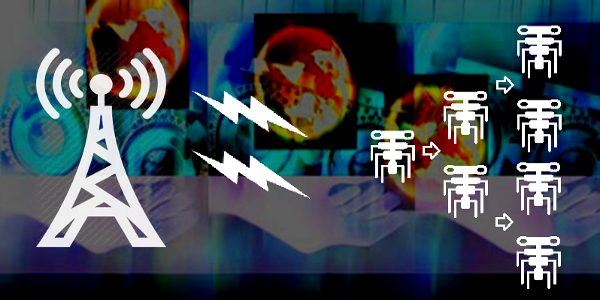BY LETTER
Bicameral von Neumann Machine Architecture
Technology > Technology Type or Material > Drytech/Hylotech
Technology > Technology Type or Material > Nanotech
Technology > Technology Type or Material > Syntech/Synanotech
Technology > Technology Type or Material > Nanotech
Technology > Technology Type or Material > Syntech/Synanotech
Self-replicating machines using replication code which is stored at a remote location |
 Image from Steve Bowers |
Terminology key:
"Praxic", derived from the Latin praxis, meaning "to do".
"Camera", Latin for "chamber".
The Bicameral von Neumann Machine Architecture is a fundamental architecture for the design of self-replicating machines that are resistant to uncontrolled self-replication and operation.
The structure of the architecture consists of physically separating the software and praxic-hardware of a self-replicating machine into two camerae. The software camera is stored at a remote location 1 and the software is continuously streamed via carrier-medium to a receiver that is present on the praxic-hardware portion of a given von Neumann machine, or is in communication with it.
The Bicameral Architecture 2 should not be confused with teleoperation. The praxic-hardware camerae function autonomously within their approved theater of action. The simplest and smallest hardware functions totally on programmed instinctive behavior, but it is nonetheless capable of comparatively sophisticated operation and feats of construction because its programming is not limited to what could be stored within its volume if it had proportionally significant onboard memory.
The praxic-hardware camera is physically incapable of locally storing its system software and manufacturing design templates because it has multiple orders of magnitude less than the required memory.
Additional safety measures beyond those of the minimal architecture are also possible, and are employed when praxic-camerae are not simple instinct-driven automations, but sub-sophont sentient entities. The onboard memory hardware can be engineered to reject the storage of the software formats that the system software and design templates are written in. Another option is small-but-critical portions of the software (which control key low-level autonomic functions and molecular manufacturing hardware) are transmitted in encrypted form. The signal decrypter and controllers run on quantum encrypted hardware, and thus are perfectly secure against being read from the outside by rogue praxic-camerae. Another option that supplements the previous one is engineering the software that runs on the higher cognitive CPUs to be incapable of opening the file formats that molecular manufacturing design templates are written in; this prevents an AI from devising and manufacturing a cracked version of the encrypted hardware that isn't secure against being read, and pooling its memory resources with others or reengineering itself to have greater onboard memory in an attempt to work around the safeguards.
In the event that a machine behaves outside acceptable parameters, its operation (and simultaneously all others of its type operating on the same transmission) can be halted by terminating the software streaming.
The Bicameral Architecture allows gifted swarm-, spore-, and seedtech to be safely employed even by modosophonts. Although transapient-tech von Neumann machines are extremely reliable against rogue behavior, transapients are known to utilize the Architecture as a fail-safe for their most powerful Neumann-tech.
BvNMA spore-tech praxic-camerae utilize a fullertube nanoradio to receive the software streaming. Seedtech and larger camerae utilize orbital angular momentum (OAM) multiplexing antennae or deploy optical receivers for laser-based transmissions.
Footnotes:
[1] If the theater of action for von Neumann machines is an entire planet, typically the software is streamed from geostationary satellites and polar statites. Smaller action-theaters allow for more proximate software camerae. More proximate repeater hardware is sometimes employed to receive, amplify, and rebroadcast the transmission; this eases the required broadcasting power of the software camerae in orbit. To reach praxic-camerae that are operating underground or in liquid depths, repeater hardware translates the transmissions into modulated light signals sent over optical fiber umbilicals.↩
[2] The concept of the Bicameral Architecture dates back to the Information Age under the name Broadcast Architecture, and was devised as a safeguard for then-theoretical molecular manufacturing hardware concepts that were similar to modern spore- and seedtech, i.e. able to operate outside the eutactic, ultra-high vacuum environment of a nanofactory. ↩
Related Articles
- Goo
- Neumann (Von Neumann Self-Replicating Systems)
- Paste - Text by Steve Bowers
Swarm devices manufactured by a forge system, (such as a bioforge or nanoforge) so that the individual units do not carry the code for their own replication (human red blood cells are an example of this in biology). - Swarm (nanotech or biology)
Appears in Topics
Development Notes
Text by Johnny Yesterday
Initially published on 05 September 2015.
Initially published on 05 September 2015.






